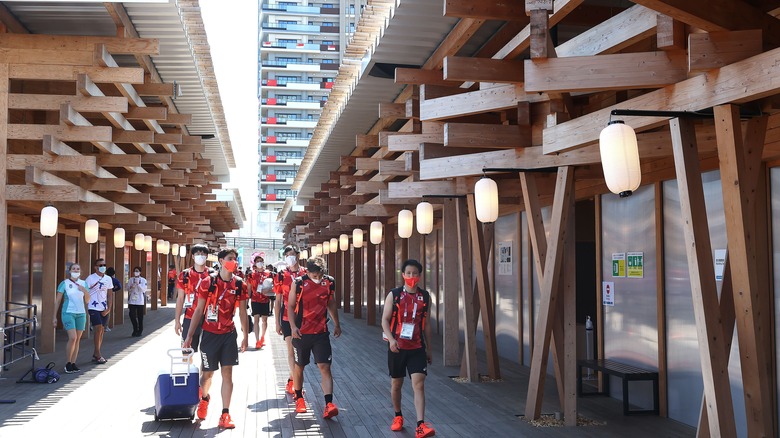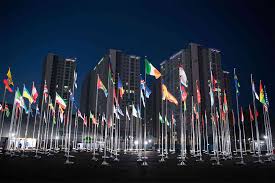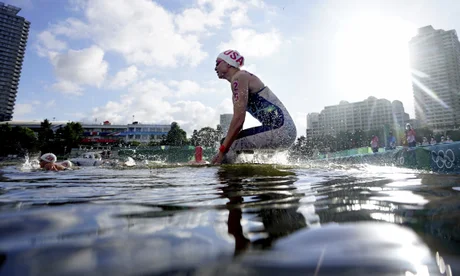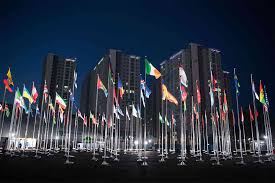Olympian Reveals Wild Story About Life Inside the Olympic Village
By BBC Sport | 19 May 2025
The human element of the Games is often far more than the competition and medals. The former Olympian Josh Lakatos has lifted the curtain on what he described as “the most debaucherous days” of his life. He recalled incidents that took place behind closed doors in the Olympic Village during the Sydney 2000 Games.
A Village With a Reputation
Every four years thousands of athletes from all over the world compete for this year’s Olympic Games. Many consider the highest point is achieving a medal on the biggest stage in sports. However, the Olympic Village — where athletes stay eating, rest, and recuperate has earned a name that extends beyond sports.
Since the end of the 20th century, rumors have been floating around about the Village being not only a place for athletes, but also a hub for late-night activities. It’s a place in which the best athletes of the world typically in their 20s and beyond, gather in a place that is largely hidden from the spotlight but united in excitement and tension.
The organizers themselves have acknowledged this fact. Since 1988, the Seoul Games, Olympic committees have offered free condoms for athletes in order to encourage safety methods of practice. The distribution of condoms has been a regular feature of the Games and has seen hundreds of thousand condoms given out every year.




Even the most practical hurdles, such as the infamous cardboard beds that were discussed in Tokyo 2020 or Paris 2024 haven’t done anything to hinder the social aspect. For many athletes it is clear that it’s clear that the Olympic Village is as much about sharing experiences as it is about competition.
Lakatos’ Story
Josh Lakatos, a former American trap shooter, competed in at the Sydney Games in 2000 as an experienced Olympian who had already taken home the silver medal in Atlanta 1996. When his competition responsibilities ended at a very early date, Lakatos revealed that he continued to stay in Sydney even after the official timeframe was set to come to an end.
In an ESPN article that reflected on the reputation of the Village, Lakatos admitted he deliberately discovered a way to prolong his time at the Village. When the athletes were required to leave the facility, he persuaded the staff member to not declare him, which allowed Lakatos access to the Village, despite the rules that required his withdrawal.
“I was staying on the ground floor of a three-storey unit,” Lakatos remembered. “Once word spread, people started showing up–track and field athletes, friends from other teams, even a whole Scandinavian-looking women’s relay squad.”
The next day, Lakatos said he witnessed an event he will never ever forget: “I swear, the whole women’s 4×100 relay team from a Scandinavian country left the house, being followed by our boys. We had just seen them race the previous night.”
The “Shooters’ House”
The initial gathering soon grew into a massive one. According to Lakatos the word spread quickly and his home turned into an unofficial social center in the Village. The place was dubbed “Shooters’ House,” and for an entire week, it became the place where athletes could escape from the attention of cameras and officials.
“The condoms from the clinic were being put to good use,” he said. “I believed I was running a brothel within the Olympic Village. I’ve never experienced anything like this before in my life.”
Lakatos His candid memories highlight the truth of what insiders have suggested for years that while the media is dominated by competition The Village itself can be quite different from the rest of the world.
Other Athletes Speak Out
Lakatos isn’t the only Olympian who has spoken out about the culture within the Village. An ex- United States women’s football goalkeeper who was interviewed by the same magazine she said the intimacy of the Village was not hidden.
“People weren’t even discreet,” she explained. “You’d find couples on the lawn, in between buildings, and about. It was all the way of life in those days.”
These accounts are a part of the countless years of reports about what takes place behind closed doors during the Games. Although it is true that the International Olympic Committee (IOC) is not often provided direct feedback on these issues but it has always advocated safe practices through the provision of protection for free.
The Condom Tradition
The practice of giving condoms first started during the 1988 Games in Seoul, initially as part of an awareness campaign about HIV/AIDS. Since then, it’s become a norm, with the number growing to meet the demands.
For Rio 2016, at the Rio 2016 Olympics At the Rio 2016 Olympic Games, 450,000 condoms were handed out to athletes. In Tokyo 2020, which was held despite the restrictions because of the COVID-19 pandemic organizers distributed 160,000 condoms.
Most recently, the Paris 2024 Games continued the tradition, offering around 300,000 condoms to 10,500 athletes that were in attendance. Officials said there were “no restrictions regarding sexual activity,” highlighting the IOC’s dedication to promoting safety, rather than control private conduct.
Why These Stories Endure
For many, the attraction to lifestyles in the Olympic Village originates from the stark contrast between the athletes’ appearance on television and personal real-life experiences. Olympians are frequently portrayed as models of discipline, sacrifice and concentration. But, away from the spotlights they are also young athletes who experience high pressure, intense emotions, and joy.
Sociologists believe that the Village can provide the rare feeling of liberation. For many sportsmen, Olympic competition represents the top of their careers. When their competitions are finished the relief of tension is huge and the village becomes an environment that is unique, where social interactions are abound.
These stories also reveal another aspect of the Games which isn’t often featured in the traditional media. While records, medals, and national pride make headlines The Village is a representation of the personal experience of athletes and their families, friends and, sometimes, excessive.
Criticism and Defence
Many do not see these events with enthusiasm. Some say that such stories smear the achievements of athletes and are a source for hyperbole-style representations about the Games. There are some concerns that the over-focus on village life degrades the quality in Olympic competition.
Some people defend candid accounts as a true reflection of the world. A sports psychologist has said: “Athletes are not robots. These are teenagers who live in a very intense and demanding environment. Relationships, social bonding and even romance are a part of that experience.”
The IOC has generally stayed away from announcing its opinions in favor of addressing issues via health and safety initiatives.
Then and Now
In retrospect, Lakatos describes his Sydney experience with humour, not regret. He’s 52 and calls this “the wildest time” of his life, even though he acknowledges that it was an exceptional sequence of events that is unlikely to be replicated in the same manner.
The Olympic Villages of today are more modernized with heightened media scrutiny and a tighter security. But despite these changes however, the fundamental dynamic of thousands of elite athletes crowded together the same.
There is a lot to be said about the Paris 2024 Games may have been more organized in comparison to Sydney 2000, however reports suggest that the Village atmosphere is still flourishing in its own manner. As we approach Los Angeles 2028 on the near future, the curiosity of what actually transpires behind the scenes likely to continue to grow.
A Window Into the Human Side
The truth is that Lakatos’ story is only one of many chapters in the story that is Olympic Villages. It doesn’t matter if they are humorous tales or cautionary tales simply interesting facts, these accounts provide us with the knowledge that Olympians are much more than athletes.
They are humans, capable of focus, ambition and extreme discipline, yet also capable of being able to let go when the pressure has subsided. For viewers, that mix of commitment and humanity could be the reason why this Olympic Games not only a sporting event, but also a culture-based phenomenon that is a global phenomenon.















